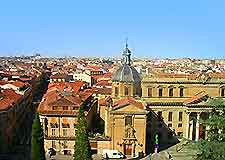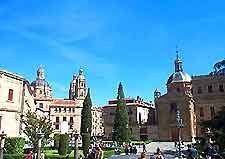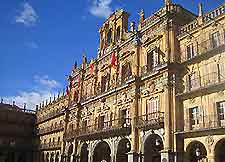Salamanca Neighborhoods, Locations and Districts
(Salamanca, Castilla y León, Spain)

Salamanca is a particularly historic city, located on the western side of Spain and edged to the south by the Tormes River. Many of Salamanca's districts and neighbourhoods merge seamlessly together, providing the feel of a truly unified city.
Much of life in Salamanca is based around the renovated Barrio Pizarrales district, a particularly historic part of Salamanca, while many of the best restaurants and bars can be found in and around the downtown district.
For those looking for nightlife attractions in Salamanca, be sure to visit the university district in the city's suburbs, which is a particularly vibrant part of Salamanca and contains many clubs and entertainment venues. Here are Salamanca's main districts, neighborhoods and locations.
Barrio Pizarrales District
The Barrio Pizarrales region of Salamanca is one of the city's oldest districts, with much of the area recently being renovated and refreshed. A mainly residential neighbourhood with numerous historic buildings, the Barrio Pizarrales lies close to the both the Avenida de Portugal and the Avenida Italia, with the Plaza Oeste and the Calle de Álvaro Gil also being located nearby.
Barrio Garrido District
A highly populated and mainly residential district of Salamanca, Barrio Garrido stretches between the Avenida de Cipreses and the Federico Anaya region, being divided into north and south area. The Barrio Garrido district is known for its interesting street names, many of which are named after Spanish conquerors and characters in history, such as the Calle Rafael Lapesa, and also flowers, including the Calle Las Petunias and the Calles Las Camelias.

Downtown District
Downtown Salamanca is the city's main district and is where many of the best tourist attractions and noteworthy landmarks are located, together with shops, restaurants and Tapas bars. Bordered to one side by the Avenida de Mirat, this district is the heart of the town, stretching from the Calle de Zamoro to the Puente Romano bridge. Highlights in downtown Salamanca include a number of popular theatres, plenty of art galleries, the famous Casa de las Conchas - located along the Rua Mayor, and both of the city's new and old cathedrals.
Also within Salamanca's downtown district are a plethora of shopping opportunities, including the Champion hypermarket along the Calle de Toro, and the popular Mercado Central, a colourful market where a range of local produce and handicrafts are sold. One of the main area's in this part of Salamanca, the Plaza Mayor is surrounded by sightseeing opportunities.

Plaza Mayor
A grand and imposing public square, constructed between 1729 and 1755, Salamanca's Plaza Mayor is central to city life and most attractive when illuminated in the evening, being surrounded by a continuous four-storey building, and also the grand City Hall (Ayuntamiento). With Baroque-style architecture, many historic stone busts and al fresco dining, the Plaza Mayor was once used to host bullfights and other notable local festivals. Many of the major tourist attractions in Salamanca are within easy walking distance of the Plaza Mayor, together with accommodation and restaurants, a number of which are located between the square at the Tormes River.
University District
Salamanca's University District is a lively part of the city, with the campus being centred around the Calle de los Libreros. The university was founded in the mid-13th century and is known for its striking sandstone architecture and detailed carvings. With around 35,000 students, this part of Salamanca is home to impressive views of the river, together with a range of café-bars, which transform into dance clubs from midnight onwards. Nightlife around the Salamanca University campus begins late at night, with many clubs and entertainment venues remaining open until the early hours of the morning.
Other Districts
Standing across the Tormes River from downtown Salamanca you will find a number of small, charming districts, situated on the outskirts of the city. With a definite Spanish feel, notable areas here include Chamberi, San José and Tejares, all of which feature white-washed houses and many historic stone buildings.
 Salamanca is a particularly historic city, located on the western side of Spain and edged to the south by the Tormes River. Many of Salamanca's districts and neighbourhoods merge seamlessly together, providing the feel of a truly unified city.
Salamanca is a particularly historic city, located on the western side of Spain and edged to the south by the Tormes River. Many of Salamanca's districts and neighbourhoods merge seamlessly together, providing the feel of a truly unified city.
